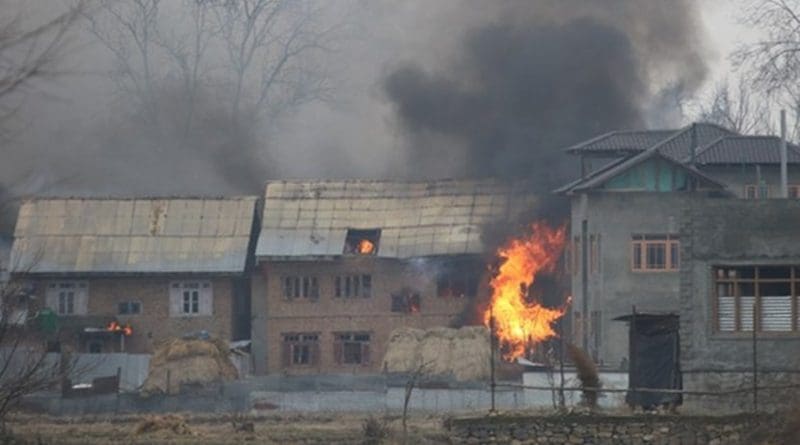Unresolved Tensions: Reflections On Four Years Since the Pulwama-Balakot Crisis – OpEd
Four years have passed since the Pulwama-Balakot crisis, which brought India and Pakistan to the brink of a full fledge war. The incident occurred on February 14, 2019, when a convoy of vehicles carrying Indian paramilitary troops was attacked by a suicide bomber in Pulwama, in the Indian Illegally Occupied Jammu and Kashmir (IIOJK).
The attack resulted in the deaths of 46 Indian soldiers. The attack led to a major escalation of tensions between India and Pakistan, with India accusing Pakistan of supporting and financing the terrorist group responsible for the attack.
On February 26, 2019, the Indian Air Force launched airstrikes on what it claimed to be training camps in Balakot, Pakistan. The airstrikes were carried out in retaliation for the Pulwama attack, and India claimed that they had successfully destroyed the militant camps, killing a large number of militants. Pakistan, however, denied India’s claims, stating that the Indian airstrikes had caused minimal damage and no casualties. Pakistan also rejected India’s accusations that it was responsible for the Pulwama attack. In response to the Indian airstrikes, Pakistan launched “Operation Swift Retort,” with the Pakistan Air Force (PAF) carrying out airstrikes on Indian military targets in IIOJK. The PAF also shot down an Indian fighter jet and captured its pilot, who was later released as a goodwill gesture.
While the Indian airstrikes in Balakot were widely seen as a show of aggression, the PAF’s response in the form of Operation Swift Retort has been credited with restoring deterrence in the region. The PAF’s ability to carry out strikes on Indian military targets sent a clear message to India that any future military action would be met with a swift and strong response from Pakistan. The success of Operation Swift Retort has been attributed to several factors. First, the PAF’s use of modern, sophisticated equipment and technology enabled it to carry out effective strikes against Indian targets. Second, the PAF’s tactics, including the use of surprise and speed, caught the Indian military off-guard, giving the PAF an advantage. Third, Pakistan’s ability to shoot down an Indian fighter jet and capture its pilot added to the PAF’s success and reinforced the message that Pakistan was capable of defending its airspace and territory.
Pakistan’s Operation Swift Retort demonstrated the country’s military capabilities and its willingness to respond to any aggression from India. The operation not only restored Pakistan’s deterrence capabilities but also highlighted the need for both countries to engage in dialogue and diplomacy to avoid further escalation of tensions. In the aftermath of the crisis, both India and Pakistan have emphasized the need for dialogue and diplomacy to resolve their differences. However, progress toward resolving the Kashmir dispute and improving bilateral relations has been slow, and the risk of a potential conflict remains high.
The region’s stability and peace remain fragile, and the situation in Kashmir continues to be a source of tension between India and Pakistan. The crisis highlighted the dangers of a potential nuclear conflict between the two countries and underscored the need for diplomatic efforts to resolve their differences. It was a stark reminder of the dangers of a potential nuclear conflict between India and Pakistan. Both countries possess nuclear weapons and have engaged in military conflicts in the past, raising concerns about the possibility of a nuclear war in the region. The crisis highlighted the need for diplomatic efforts to resolve their differences and reduce the risk of a catastrophic conflict.
Tensions between India and Pakistan remain high, with the Kashmir dispute remaining unresolved. The crisis highlighted the dangerous nature of the South Asian region, where a small conflict could potentially escalate into a full-scale war with catastrophic consequences. Furthermore, India’s unilateral decision to revoke the special constitutional status of Kashmir in August 2019 has further complicated the situation, with the region still experiencing a partial lockdown and communication blackout. This move implies that India seeks to dominate the escalation ladder of the region with its provocative and offensive policies, further adding to the tensions.
In conclusion, four years after the Pulwama-Balakot crisis, the situation in the South Asian region remains fragile and volatile. The crisis highlighted the need for both India and Pakistan to resolve the Kashmir dispute. The international community, including the United Nations, can also play a role in facilitating dialogue and promoting peace and stability in the region. The path to peace and stability in South Asia is a challenging one, but with sustained efforts and cooperation, it can be achieved. To achieve lasting peace and stability in the South Asian region, both India and Pakistan must continue to engage in dialogue and take steps toward resolving the Kashmir dispute.
Muhammad Haris is an Islamabad-based researcher and policy analyst. He frequently writes on issues related to regional security with a special focus on contemporary South Asia.

